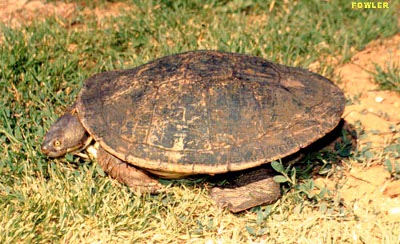Murray River Turtle
Category: Turtle

Facts about Murray River Turtles. "Scientific name for Murray River Turtle is Emydura macquarii". Murray River Turtle also goes by the names Murray short-necked turtle or Macquarie turtle. The Murray River Turtle is found in Murray-Darling River located in the southeastern part of Australia. Compared to the other varieties of turtles, this type of turtle is slightly bigger growing up to lengths of 30 cm (11 7/8 inches).
Description of Murray River Turtles
Murray River Turtle exhibits sexual dimorphism in that the male has a much longer and fatter tail while that of the female Murray River Turtle is thinner and shorter. The Murray River Turtle has two barbels that are fleshy under its chin and a shell that is medium to dark brown in color on the upper side and cream colored on the lower side. The skin of the Murray River Turtle is grey in color with a creamy yellow stripe that runs along the side of its head to the corner of its mouth. Compared to other turtles, the Murray River Turtle has eyes that are yellow and small with pupils that are round and black in color. This makes it very colorful.
Behavior of Murray River Turtle
The Macquarie turtle usually folds its neck in a backward motion and hides itself in the shell whenever it spots danger. These turtles do not have an outer ear system but they have an inner ear complex with a set of auditory nerves that enable them to centralize the hearing function.
The Murray River Turtle gather sound vibrations from the external environment and amplify them so as to make it louder because turtles do not hear airborne sounds the way human beings do. The Murray River Turtle only sense and interpret sound vibrations to decode the presence or absence of danger. In addition to the hearing system, they also have an excellent sense of smell and vision. Being cold blooded animals, the Murray River Turtles usually bask on rocks in the sun so as to gain heat to keep them going.
Habitat of Murray River Turtle
Murray River Turtles are usually found on the southern part of the equator together with other side-neck turtles. They inhabit fresh water ecosystems such as lakes and large rivers. For many years, the Murray River Turtles have been popularized as pets and their hatchlings are usually sold as penny turtles but gradually grow into large and mature adults. The formation of the shell is dependent on the diet and the environment in which they are bred. In the event of inadequate house or insufficient diet, the Murray River Turtles can suffer from deformed shells. Some turtle owners usually damp them in rivers and ponds as they grow making them one of the most common sights in lakes, ponds and urban parks.
Reproduction of Murray River Turtle
The Murray River Turtles bred in spring and summer laying their eggs in burrows near rivers and lakes. The eggs take about 80 days to hatch. In the wild, the newly hatched turtles face the threat of predators such as wild pigs, cats, foxes, birds, rats and goannas. The adult however have a few enemies.
Feeding Habits of Murray River Turtle
When on land, the Murray River Turtles use their sense of smell to find food. While on water on the other hand, they use their barbels that contain olfactory nerve endings to enable them to find food even in muddy and dark waters.

 Back To Category Turtle
Back To Category Turtle